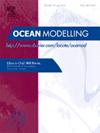Neural Synthetic Profiles from Remote Sensing and Observations (NeSPReSO) — Reconstructing temperature and salinity fields in the Gulf of Mexico
IF 2.9
3区 地球科学
Q2 METEOROLOGY & ATMOSPHERIC SCIENCES
引用次数: 0
Abstract
Accurate circulation modeling in the Gulf of Mexico (GoM) is hampered by the limited availability of in-situ subsurface data, leading to inaccuracies in subsurface representations. These inaccuracies diminish the reliability of ocean models and constrain the duration of dependable forecasts. This study introduces NeSPReSO (Neural Synthetic Profiles from Remote Sensing and Observations), a data-driven method to efficiently and accurately estimate subsurface temperature and salinity profiles using satellite-derived surface data. This provides an alternative to conventional synthetic data generation techniques.
Principal Component Analysis (PCA) is applied to extract the main features of temperature and salinity profiles of an Argo dataset. Then, a neural network is trained to predict these principal features using inputs such as time, location, and satellite-derived absolute dynamic topography alongside sea surface temperature and salinity. The model, evaluated using additional Argo profiles and glider data collected in the Gulf of Mexico, over-performs other traditional synthetic data generation methods, such as the Gravest Empirical Modes (GEM), Multiple Linear Regression (MLR) and Improved Synthetic Ocean Profile (ISOP), in terms of root mean square error and bias. Our findings indicate that our method effectively captures the main variations of subsurface fields, and that synthetic profiles generated by the model align well with actual observations, accurately capturing key features such as thermoclines, haloclines, and temperature-salinity structure of the region. This new method will be implemented in GoM data assimilative models and is expected to improve the accuracy of modeled subsurface currents.
来自遥感和观测的神经合成剖面(NeSPReSO) -重建墨西哥湾的温度和盐度场
由于地下数据的有限可用性,墨西哥湾(GoM)的精确循环建模受到了阻碍,导致地下表示不准确。这些不准确性降低了海洋模式的可靠性,并限制了可靠预报的持续时间。本研究引入了NeSPReSO (Neural Synthetic Profiles from Remote Sensing and Observations),这是一种数据驱动的方法,可以利用卫星获取的地表数据高效、准确地估计地下温度和盐度剖面。这为传统的合成数据生成技术提供了另一种选择。应用主成分分析(PCA)提取了Argo数据集温度和盐度剖面的主要特征。然后,利用时间、地点、卫星获得的绝对动态地形以及海面温度和盐度等输入,训练神经网络来预测这些主要特征。该模型利用在墨西哥湾收集的Argo剖面和滑翔机数据进行了评估,在均方根误差和偏差方面优于其他传统的合成数据生成方法,如最严重经验模式(GEM)、多元线性回归(MLR)和改进的合成海洋剖面(ISOP)。我们的研究结果表明,我们的方法有效地捕获了地下场的主要变化,并且由模型生成的合成剖面与实际观测结果很好地吻合,准确地捕获了该地区的关键特征,如温跃线、盐跃线和温度-盐度结构。该方法将应用于GoM数据同化模型,有望提高模拟地下流的精度。
本文章由计算机程序翻译,如有差异,请以英文原文为准。
求助全文
约1分钟内获得全文
求助全文
来源期刊

Ocean Modelling
地学-海洋学
CiteScore
5.50
自引率
9.40%
发文量
86
审稿时长
19.6 weeks
期刊介绍:
The main objective of Ocean Modelling is to provide rapid communication between those interested in ocean modelling, whether through direct observation, or through analytical, numerical or laboratory models, and including interactions between physical and biogeochemical or biological phenomena. Because of the intimate links between ocean and atmosphere, involvement of scientists interested in influences of either medium on the other is welcome. The journal has a wide scope and includes ocean-atmosphere interaction in various forms as well as pure ocean results. In addition to primary peer-reviewed papers, the journal provides review papers, preliminary communications, and discussions.
 求助内容:
求助内容: 应助结果提醒方式:
应助结果提醒方式:


